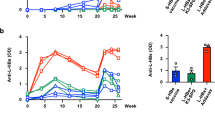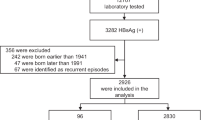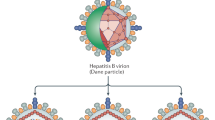Abstract
Hepatitis B virus (HBV) is an important human pathogen responsible for over 200 million cases of chronic infection, many of which progress to hepatocellular carcinoma. Although HBV cannot be propagated in tissue culture, highly effective subunit vaccines obtained from the plasma of chronically infected patients have been developed and licensed1–3. Such vaccines are safe but their expense and limited quantities make them unavailable to most Third World countries. Other approaches to vaccine construction, including purification of the HBV surface antigen (HBsAg) from genetically engineered eukaryotic cells4–13 and the synthesis of peptides predicted from the nucleotide sequence of the HBsAg gene14–19, are still under evaluation. Another potential application of recombinant DNA technology to vaccine development is the use of live virus vectors to express foreign genes20–25. An infectious vaccinia virus recombinant that expressed the HBsAg in animal cells and which stimulated the production of antibody to HBsAg (anti-HBs) in rabbits represented a novel candidate vaccine of this class22,23. As a continuation of our earlier study, we now present evidence that chimpanzees vaccinated with a live recombinant vaccinia virus were protected against hepatitis following challenge with HBV.
This is a preview of subscription content, access via your institution
Access options
Subscribe to this journal
Receive 51 print issues and online access
$199.00 per year
only $3.90 per issue
Buy this article
- Purchase on SpringerLink
- Instant access to full article PDF
Prices may be subject to local taxes which are calculated during checkout
Similar content being viewed by others
References
Szmuness, W. et al. New Engl. J. Med. 303, 833–841 (1980).
Crosnier, J. et al. Lancet i, 455–459 (1981).
Reesink, H. W. et al. Antiviral Res. 1, 13–25 (1981).
Moriarty, A. M., Hoyer, B. H., Shih, J. W.-K., Gerin, J. L. & Hamer, D. H. Proc. natn. Acad. Sci. U.S.A. 78, 2606–2610 (1981).
Dubois, M. F., Pourcel, C., Rousset, S., Chany, C. & Tiollais, P. Proc. natn. Acad. Sci. U.S.A. 77, 4549–4553 (1980).
Gough, N. & Murray, K. J. Molec. Biol. 162, 43–67 (1983).
Wang, Y., Schafer-Ridder, M., Stratoma, C., Wong, T. K. & Hofschneider, P. H. EMBO J. 1, 1213–1216 (1982).
Colbere-Garapin, F., Horodniceanu, F., Kourilsky, P. & Garapin, A. C. EMBO J. 2, 21–25 (1983).
Crowley, C. W., Liu, C.-C. & Levinson, A. D. Molec. cell. Biol. 3, 44–55 (1983).
Laub, O. et al. J. Virol. 48, 271–280 (1983).
Valenzuela, P., Medina, A., Rutter, W. J., Ammerer, G. & Hall, B. D. Nature 298, 347–350 (1982).
Miyanohara, A. et al. Proc. natn. Acad. Sci. U.S.A. 80, 1–5 (1983).
Hitzeman, R. A. et al. Nucleic Acids Res. 11, 2745–2763 (1983).
Lerner, R. A. et al. Proc. natn. Acad. Sci. U.S.A. 78, 3403–3407 (1981).
Hopp, T. P. & Woods, K. R. Proc. natn. Acad. Sci. U.S.A. 78, 3824–3828 (1981).
Dreesman, G. R. et al. Nature 295, 158–160 (1982).
Bhatnagar, P. K. et al. Proc. natn. Acad. Sci. U.S.A. 79, 4400–4404 (1982).
Prince, A. M., Ikram, H. & Hopp, T. P. Proc. natn. Acad. Sci. U.S.A. 79, 579–582 (1982).
Neurath, A. R., Kent, S. B. & Strick, N. Proc. natn. Acad. Sci. U.S.A. 79, 7871–7875 (1982).
Panicali, D. & Paoletti, E. Proc. natn. Acad. Sci. U.S.A. 79, 4927–4931 (1982).
Mackett, M., Smith, G. L. & Moss, B. Proc. natn. Acad. Sci. U.S.A. 79, 7415–7419 (1982).
Smith, G. L., Mackett, M. & Moss, B. Nature 302, 490–495 (1983).
Smith, G. L., Mackett, M. & Moss, B. UCLA Symp. molec. cell. Biol., new Ser. 8, 543–554 (1983).
Panicali, D., Davis, S. W., Weinberg, R. L. & Paoletti, E. Proc. natn. Acad. Sci. U.S.A. 80, 5364–5368 (1983).
Smith, G. L., Murphy, B. R. & Moss, B. Proc. natn. Acad. Sci. U.S.A. 80, 7155–7159 (1983).
Barker, L. F. et al. J. infect. Dis. 132, 451–458 (1975).
Buller, R. M. L., Bhatt, P. N. & Wallace, G. D. J. clin. Microbiol. 18, 1220–1225 (1983).
Tabor, E., Purcell, R. H., London, W. T. & Gerety, R. J. J. J. infect. Dis. 147, 531–534 (1983).
Hoofnagle, J. H., Gerety, R. J., Smallwood, L. A. & Barker, L. F. Gastroenterology 72, 290–296 (1977).
McAuliffe, V. J., Purcell, R. H., Gerin, J. L. & Tyeryar, F. J. in Viral Hepatitis: 1981 int. Symp. Philadelphia, 295–304 (Franklin Institute Press, 1982).
Emini, E. A., Jameson, B. A. & Wimmer, E. Nature 304, 699–703 (1983).
Mackett, M., Smith, G. L. & Moss, B. J. Virol. 49, 857–864 (1984).
Paoletti, E., Lipinskas, B. R., Samsonoff, C., Mercer, S. & Panicali, D. Proc. natn. Acad. Sci. U.S.A. 81, 193–197 (1984).
Smith, G. L. et al. Science 224, 397–399 (1984).
Author information
Authors and Affiliations
Rights and permissions
About this article
Cite this article
Moss, B., Smith, G., Gerin, J. et al. Live recombinant vaccinia virus protects chimpanzees against hepatitis B. Nature 311, 67–69 (1984). https://doi.org/10.1038/311067a0
Received:
Accepted:
Issue date:
DOI: https://doi.org/10.1038/311067a0
This article is cited by
-
Effect of Anti-HBs on Mortality Among Resolved HBV Infection: a Population-Based Prospective Cohort Study
Infectious Diseases and Therapy (2023)
-
Recent advances in the development of gene delivery systems
Biomaterials Research (2019)
-
Natural history of chronic hepatitis B virus infection
Medical Microbiology and Immunology (2015)
-
Viruses as vaccine vectors for infectious diseases and cancer
Nature Reviews Microbiology (2010)
-
Nanogram Doses of Alum-Adjuvanted HBs Antigen Induce Humoral Immune Response in Mice When Orally Administered
Archivum Immunologiae et Therapiae Experimentalis (2010)



